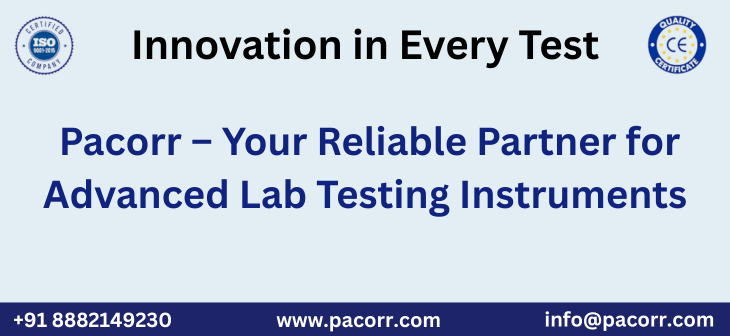
Pacorr tensile testing machines have become essential instruments across industries that demand rigorous quality assurance and precise material testing. Calibrating your tensile testing machine accurately according to ISO standards ensures reliability, compliance, and consistency in test results. Pacorr is renowned for manufacturing robust and precise tensile testers that adhere to global standards, including ISO regulations. This detailed guide will explain the calibration procedure for a tensile testing machine, highlight essential keywords such as tensile testing machine, calibration, ISO standards, and provide insightful, practical knowledge aimed at achieving accurate and reproducible outcomes.
Understanding the Importance of Calibration in Tensile Testing Machines
Calibration is critical for ensuring that tensile testing machines deliver accurate measurements. Pacorr machines, being sophisticated and precise instruments, require routine calibration to maintain their accuracy. ISO standards specifically mandate calibration to ensure that the measurements and results are both accurate and repeatable. By regularly calibrating your tensile testing machine, you prevent inaccuracies, reduce testing discrepancies, and maintain compliance with international quality standards.
ISO Standards Governing Tensile Testing Machine Calibration
ISO standards, specifically ISO 7500-1, define the calibration and verification requirements for tensile testing machines. This standard specifies the procedures to calibrate and verify force measurement systems of the tensile tester, ensuring that the machine operates within defined parameters and generates dependable data. Adhering strictly to these standards assures stakeholders and regulatory bodies of your commitment to quality control and accurate material testing.
Detailed Calibration Procedure for Pacorr Tensile Testing Machines
The calibration of a tensile testing machine per ISO 7500-1 standards involves several systematic steps:
Step 1: Initial Inspection and Preparation
Before beginning the calibration procedure, inspect the tensile testing machine thoroughly. Ensure there are no visible damages or faults. Pacorr machines are designed to facilitate easy inspection and maintenance, providing a hassle-free start to the calibration process. Confirm that the testing environment meets ISO requirements concerning temperature and humidity.
Step 2: Selection and Preparation of Reference Standards
Use reference load cells calibrated and traceable to national standards. These reference load cells must have a known accuracy higher than that of your tensile testing machine. Pacorr’s tensile testers integrate seamlessly with these standards, providing straightforward compatibility and effective calibration.
Step 3: Mounting the Reference Load Cell
Mount the calibrated load cell securely into the testing machine. Ensure that alignment is correct to prevent measurement errors. Precise alignment is crucial for achieving accurate calibration results, a critical aspect that Pacorr machines simplify with precise engineering and easy-to-use interfaces.
Step 4: Calibration Execution
Initiate the calibration process by applying incremental loads as per ISO 7500-1 recommendations. Typically, calibration requires at least five different loading points within the machine’s operational range, starting from the minimum to the maximum load capacity. Record the values displayed by the tensile testing machine against the known values from the reference load cell.
Step 5: Verification and Adjustment
Compare the readings obtained from the tensile testing machine with the reference load cell values. Any discrepancies must be adjusted through the machine's calibration settings. Pacorr tensile testing machines offer intuitive adjustment interfaces, making the calibration corrections straightforward and precise.
Step 6: Documentation and Reporting
Properly document all calibration activities and results as stipulated by ISO standards. Record details such as date, calibration points, adjustments made, and final accuracy achieved. Pacorr’s tensile testing machines come with user-friendly software solutions to facilitate comprehensive and easily retrievable documentation.
Frequency of Calibration According to ISO Standards
ISO standards recommend annual calibration of tensile testing machines or whenever significant maintenance or repair activities occur. Regular calibration ensures the accuracy and reliability of test results, significantly reducing quality control issues and improving product dependability. Pacorr recommends aligning with these intervals to maintain optimal performance and compliance.
Common Challenges in Tensile Testing Machine Calibration and How to Overcome Them
Calibration is generally straightforward but can encounter challenges such as:
- Misalignment Issues: Ensure careful mounting and alignment of the load cell and grips.
- Environmental Variations: Maintain stable environmental conditions as specified by ISO guidelines.
- Instrument Drift: Conduct regular interim checks between scheduled calibrations to identify and rectify any drift.
Pacorr tensile testing machines are engineered to minimize these common issues, enhancing reliability and reducing downtime.
Advantages of Regular Calibration of Pacorr Tensile Testing Machines
Regular calibration as per ISO standards provides numerous benefits:
- Enhanced accuracy and consistency of test results
- Compliance with international quality standards
- Improved confidence in product quality and testing reliability
- Reduced risks of quality issues in manufactured products
- Extended lifespan and optimized performance of testing equipment
Pacorr tensile testing machines specifically benefit from regular calibration due to their high-precision design and engineering quality, providing consistent, reliable data across varied testing conditions.
Conclusion
Adhering to ISO standards for calibrating your tensile testing machine is fundamental to maintaining quality and ensuring the accuracy and reliability of your material testing processes. Pacorr tensile testing machines are designed to simplify the calibration process while adhering strictly to ISO 7500-1 standards, ensuring accuracy, compliance, and consistent performance. Regularly calibrating your Pacorr tensile testing machine guarantees precision in your material testing outcomes, thereby elevating your quality control procedures and reinforcing your industry standing as a trusted provider.
By following this comprehensive calibration procedure, your business benefits from reliable test data, sustained regulatory compliance, and enhanced customer satisfaction, reflecting positively on your reputation and operational excellence.
Thanks to Pacorr Testing instruments, we have all the required quality testing instruments that have helped us to ensure the best quality delivered to our clients.

Danish
Fair Exports Pvt. Ltd.

